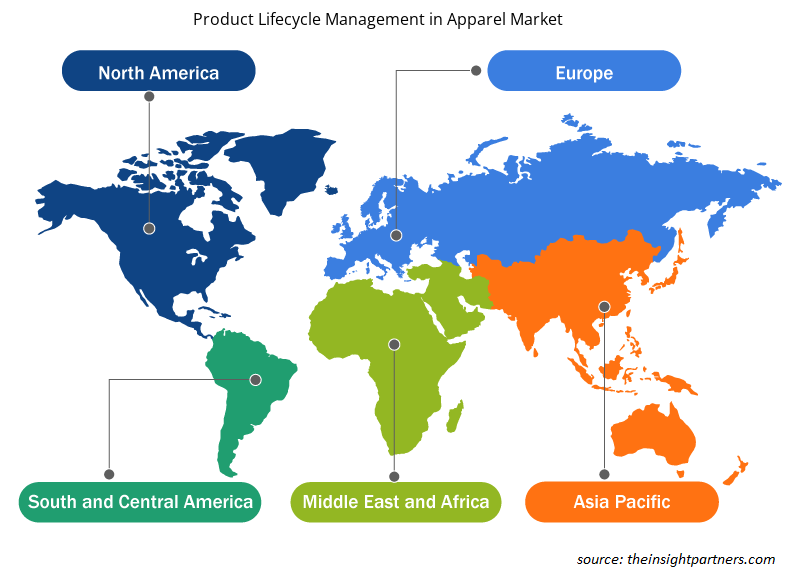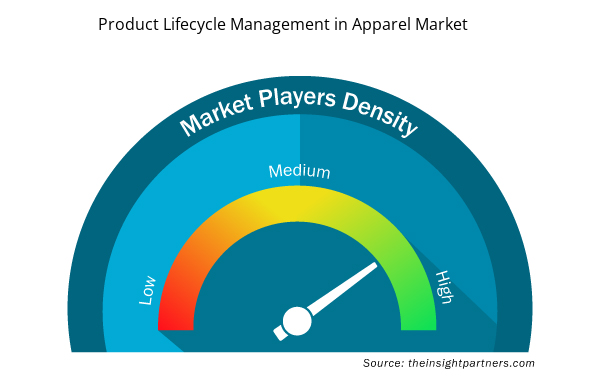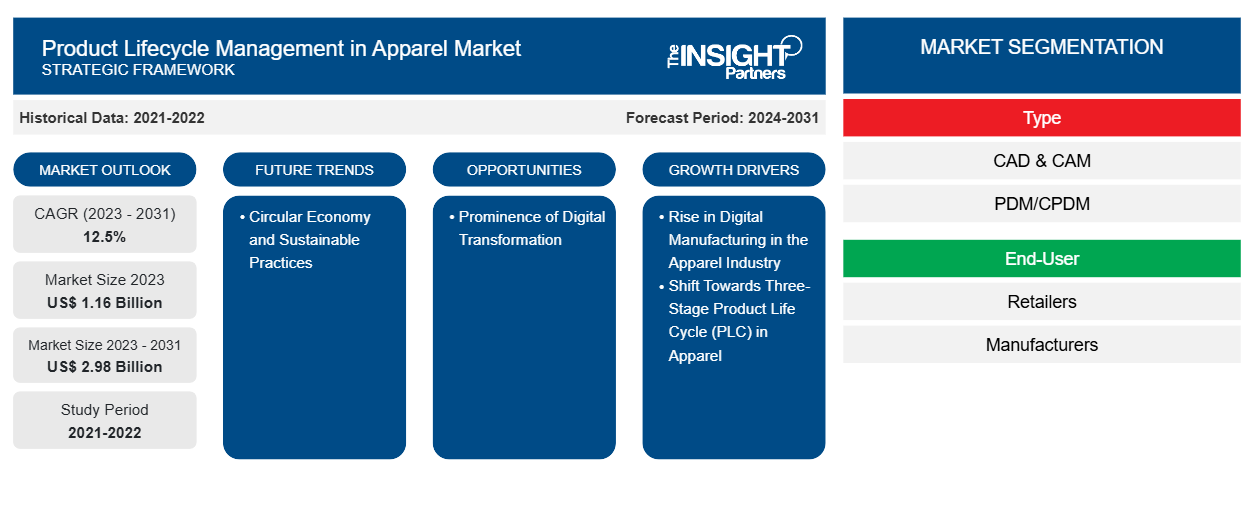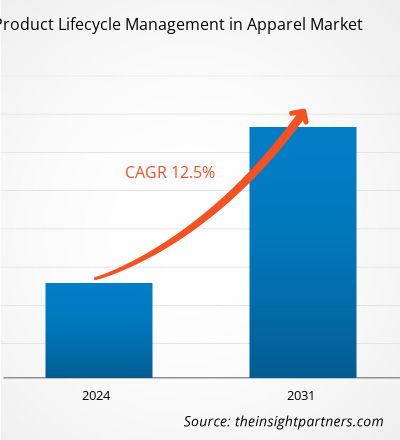Das Marktvolumen für Produktlebenszyklusmanagement im Bekleidungsbereich soll von 1,16 Milliarden US-Dollar im Jahr 2023 auf 2,98 Milliarden US-Dollar im Jahr 2031 anwachsen. Der Markt dürfte zwischen 2023 und 2031 eine durchschnittliche jährliche Wachstumsrate (CAGR) von 12,5 % verzeichnen. Kreislaufwirtschaft und nachhaltige Praktiken sowie die Betonung der digitalen Transformation werden voraussichtlich weiterhin die wichtigsten Trends im Bereich Produktlebenszyklusmanagement im Bekleidungsmarkt bleiben.
Produktlebenszyklusmanagement in der Bekleidungsmarktanalyse
Schnelle Veränderungen im Geschmack der Verbraucher kennzeichnen die Modebranche und die kürzere Produktlebensdauer, was ihre Komplexität noch erhöht. Diese Veränderungen schaffen Schwierigkeiten und Perspektiven in vielen Bereichen des Sektors, wie etwa in der Herstellung, bei Produktionsmethoden, Standards sowie bei Werbe- und Marketingbemühungen.
Produktlebenszyklusmanagement im Bekleidungsmarkt – Überblick
In der Bekleidungsindustrie ist das Product Lifecycle Management (PLM) ein strategischer Ansatz zur Überwachung des gesamten Lebenszyklus eines Produkts, von seinem ersten Entwurf und seiner Entwicklung bis zu seiner offiziellen Markteinführung, Wartung und Entsorgung. Diese umfassende Methode umfasst die Verwaltung aller Aktivitäten im Zusammenhang mit dem Lebenszyklus eines Produkts, wie Herstellung, Marketing und eventuelle Marktrücknahme. Durch den PLM-Ansatz kann die Branche analysieren, wie gut ein Produkt im Laufe der Zeit vom Markt angenommen wird, einschließlich erheblicher Umsatzschwankungen.
Passen Sie diesen Bericht Ihren Anforderungen an
Sie erhalten kostenlos individuelle Anpassungen an jedem Bericht, einschließlich Teilen dieses Berichts oder einer Analyse auf Länderebene, eines Excel-Datenpakets sowie tolle Angebote und Rabatte für Start-ups und Universitäten.
- Holen Sie sich die wichtigsten Markttrends aus diesem Bericht.Dieses KOSTENLOSE Beispiel umfasst eine Datenanalyse von Markttrends bis hin zu Schätzungen und Prognosen.
Product Lifecycle Management im Bekleidungsmarkt – Treiber und Chancen
Anstieg der digitalen Fertigung in der Bekleidungsindustrie soll den Markt ankurbeln
Der Aufstieg der digitalen Fertigung in der Bekleidungsindustrie wird voraussichtlich erhebliche Auswirkungen auf den Bedarf an robusten und zuverlässigen Produktlebenszyklusmanagementsystemen (PLM) haben. Dies liegt vor allem an den komplexen Prozessen der digitalen Fertigung, einschließlich Konzeption, Design, Planung und Ausführung, die alle den umfassenden Einsatz von PLM- Software wie CAD und CAM erfordern. Infolgedessen wird erwartet, dass der Ausbau der digitalen Fertigung den Bedarf an PLM-Systemen steigern und so den Fortschritt des Produktlebenszyklusmanagements im Bekleidungsmarkt im Prognosezeitraum vorantreiben wird.
Bedeutung der digitalen Transformation
Der kontinuierliche Wandel hin zur Digitalisierung hat neue Wege für Innovationen eröffnet und moderne Technologien wie maschinelles Lernen (ML), künstliche Intelligenz (KI), Robotik und das Internet der Dinge (IoT) integriert, um den Weg in die Ära der vierten industriellen Revolution (Industrie 4.0) zu ebnen. In der Industrie 4.0 ermöglicht die Verschmelzung von Elektronik und Informationstechnologie die nahtlose digitale Integration der physischen, digitalen und biologischen Aspekte des modernen menschlichen Lebens. Dies stellt einen bedeutenden Wandel für die Fertigungsindustrie dar, insbesondere bei der Produktion von Massengütern wie Kleidung und Schuhen, da Industrie 4.0 einen revolutionären Wandel einleitet. digitalization has opened up new avenues for innovation, incorporating advanced technologies such as machine learning (ML), artificial intelligence (AI), robotics, and the Internet of Things (IoT) to lead the way into the era of the fourth industrial revolution (Industry 4.0). In Industry 4.0, the blending of electronics and information technology facilitates the seamless digital integration of the physical, digital, and biological aspects of modern human life. This marks a significant change for the manufacturing industry, particularly in the production of mass-manufactured goods like clothing and footwear, as Industry 4.0 instigates a revolutionary transformation.
Produktlebenszyklusmanagement im Bekleidungsmarktbericht – Segmentierungsanalyse
Wichtige Segmente, die zur Ableitung des Produktlebenszyklusmanagements in der Bekleidungsmarktanalyse beigetragen haben, sind Typ und Endbenutzer.
- Nach Typ ist der Markt in CAD & CAM und PDM/CPDM unterteilt. Das CAD & CAM-Segment hatte im Jahr 2023 einen bedeutenden Marktanteil.
- In Bezug auf die Endverbraucher ist der Markt segmentiert in Einzelhändler,Hersteller und andere. Das Herstellersegment hielt im Jahr 2023 einen erheblichen Marktanteil.
Product Lifecycle Management in der Bekleidung – Marktanteilsanalyse nach geografischer Lage
Der geografische Umfang des Marktberichts zum Produktlebenszyklusmanagement in der Bekleidungsindustrie ist hauptsächlich in fünf Regionen unterteilt: Nordamerika, Asien-Pazifik, Europa, Naher Osten und Afrika sowie Südamerika/Süd- und Mittelamerika.
Das Produktlebenszyklusmanagement im europäischen Bekleidungsmarkt umfasst die Verwaltung des gesamten Lebenszyklus von Modeprodukten und befasst sich mit den besonderen Herausforderungen, die sich durch schnelllebige Trends und Verbraucherpräferenzen ergeben. Es wird erwartet, dass der Markt ein erhebliches Wachstum verzeichnen wird, und die Anpassung an die sich ändernde Marktdynamik bietet Unternehmen der europäischen Bekleidungsindustrie Chancen.
Produktlebenszyklusmanagement im Bekleidungsmarkt – regionale Einblicke
Die regionalen Trends und Faktoren, die das Produktlebenszyklusmanagement im Bekleidungsmarkt während des Prognosezeitraums beeinflussen, wurden von den Analysten von Insight Partners ausführlich erläutert. In diesem Abschnitt werden auch die Marktsegmente und die Geografie des Produktlebenszyklusmanagements im Bekleidungsmarkt in Nordamerika, Europa, im asiatisch-pazifischen Raum, im Nahen Osten und Afrika sowie in Süd- und Mittelamerika erörtert.

- Erhalten Sie regionalspezifische Daten zum Produktlebenszyklusmanagement im Bekleidungsmarkt
Umfang des Marktberichts zum Produktlebenszyklusmanagement in der Bekleidung
| Berichtsattribut | Details |
|---|---|
| Marktgröße im Jahr 2023 | 1,16 Milliarden US-Dollar |
| Marktgröße bis 2031 | 2,98 Milliarden US-Dollar |
| Globale CAGR (2023 - 2031) | 12,5 % |
| Historische Daten | 2021-2022 |
| Prognosezeitraum | 2024–2031 |
| Abgedeckte Segmente | Nach Typ
|
| Abgedeckte Regionen und Länder | Nordamerika
|
| Marktführer und wichtige Unternehmensprofile |
|
Marktteilnehmerdichte: Der Einfluss auf die Geschäftsdynamik
Der Markt für Produktlebenszyklusmanagement im Bekleidungsmarkt wächst rasant, angetrieben durch die steigende Nachfrage der Endnutzer aufgrund von Faktoren wie sich entwickelnden Verbraucherpräferenzen, technologischen Fortschritten und einem größeren Bewusstsein für die Vorteile des Produkts. Mit steigender Nachfrage erweitern Unternehmen ihr Angebot, entwickeln Innovationen, um die Bedürfnisse der Verbraucher zu erfüllen, und nutzen neue Trends, was das Marktwachstum weiter ankurbelt.
Die Marktteilnehmerdichte bezieht sich auf die Verteilung der Firmen oder Unternehmen, die in einem bestimmten Markt oder einer bestimmten Branche tätig sind. Sie gibt an, wie viele Wettbewerber (Marktteilnehmer) in einem bestimmten Marktraum im Verhältnis zu seiner Größe oder seinem gesamten Marktwert präsent sind.
Die wichtigsten Unternehmen, die im Bereich Product Lifecycle Management im Bekleidungsmarkt tätig sind, sind:
- C-DESIGN Mode
- Computergenerierte Lösung
- Dassault Systemes
- EFI Optitex
- Gerber Technology LLC
- Infor Inc.
Haftungsausschluss : Die oben aufgeführten Unternehmen sind nicht in einer bestimmten Reihenfolge aufgeführt.

- Überblick über die wichtigsten Akteure des Product Lifecycle Managements im Bekleidungsmarkt
Produktlebenszyklusmanagement im Bekleidungsmarkt – Neuigkeiten und aktuelle Entwicklungen
Das Produktlebenszyklusmanagement im Bekleidungsmarkt wird durch die Erfassung qualitativer und quantitativer Daten nach Primär- und Sekundärforschung bewertet, die wichtige Unternehmensveröffentlichungen, Verbandsdaten und Datenbanken umfasst. Im Folgenden finden Sie eine Liste der Entwicklungen auf dem Markt:
- Aptean, ein globaler Anbieter unternehmenskritischer Unternehmenssoftwarelösungen, gab die Übernahme von Momentis bekannt, einem Anbieter spezieller Softwarelösungen für die Mode-, Bekleidungs-, Schuh-, Textil- und Accessoire-Branche.
(Quelle: Aptean Inc., Pressemitteilung, 2024)
- Infor®, das branchenweite Cloud-Unternehmen, gab heute die Verfügbarkeit einer dedizierten Schnittstelle zwischen Made2Flow, einem auf die Analyse und Validierung von Umweltdaten in der Modebranche spezialisierten Technologieunternehmen, und Infor Product Lifecycle Management (PLM) bekannt. Die Schnittstelle erleichtert die Datenverarbeitung und vollständige Transparenz für globale Modemarken, die die Transparenz der Produktionslieferkette erhöhen möchten. Entscheidend ist, dass sie die Rückverfolgbarkeit und Auswirkungsmessung auf den Ebenen eins bis vier unterstützt.
(Quelle: Infor, Pressemitteilung, 2023)
Bericht zum Product Lifecycle Management im Bekleidungsmarkt – Umfang und Ergebnisse
Der Bericht „Marktgröße und Prognose zum Produktlebenszyklusmanagement in der Bekleidungsindustrie (2021–2031)“ bietet eine detaillierte Analyse des Marktes, die die folgenden Bereiche abdeckt:
- Marktgröße und Prognose auf globaler, regionaler und Länderebene für alle wichtigen Marktsegmente, die im Rahmen des Projekts abgedeckt sind
- Marktdynamik wie Treiber, Beschränkungen und wichtige Chancen
- Wichtige Zukunftstrends
- Detaillierte PEST/Porters Five Forces- und SWOT-Analyse
- Globale und regionale Marktanalyse mit wichtigen Markttrends, wichtigen Akteuren, Vorschriften und aktuellen Marktentwicklungen
- Branchenlandschaft und Wettbewerbsanalyse, einschließlich Marktkonzentration, Heatmap-Analyse, prominenten Akteuren und aktuellen Entwicklungen
- Detaillierte Firmenprofile
- Historische Analyse (2 Jahre), Basisjahr, Prognose (7 Jahre) mit CAGR
- PEST- und SWOT-Analyse
- Marktgröße Wert/Volumen – Global, Regional, Land
- Branche und Wettbewerbsumfeld
- Excel-Datensatz



Report Coverage
Revenue forecast, Company Analysis, Industry landscape, Growth factors, and Trends

Segment Covered
This text is related
to segments covered.

Regional Scope
North America, Europe, Asia Pacific, Middle East & Africa, South & Central America

Country Scope
This text is related
to country scope.
Häufig gestellte Fragen
The market was estimated to be US$ 1.16 billion in 2023 and is expected to grow at a CAGR of 12.5% during the forecast period 2023 - 2031.
The growth in digital manufacturing in the apparel industry is the major factor that propels product lifecycle management in apparel market.
Circular economy and sustainable practices are anticipated to play a significant role in the product lifecycle management in apparel market in the coming years.
The key players in the market are C-DESIGN Fashion, Computer Generated Solution, Dassault Systemes, EFI Optitex, and Gerber Technology LLC.
The market is expected to reach US$ 2.98 billion by 2031.
Trends and growth analysis reports related to Technology, Media and Telecommunications : READ MORE..
The Insight Partners performs research in 4 major stages: Data Collection & Secondary Research, Primary Research, Data Analysis and Data Triangulation & Final Review.
- Data Collection and Secondary Research:
As a market research and consulting firm operating from a decade, we have published and advised several client across the globe. First step for any study will start with an assessment of currently available data and insights from existing reports. Further, historical and current market information is collected from Investor Presentations, Annual Reports, SEC Filings, etc., and other information related to company’s performance and market positioning are gathered from Paid Databases (Factiva, Hoovers, and Reuters) and various other publications available in public domain.
Several associations trade associates, technical forums, institutes, societies and organization are accessed to gain technical as well as market related insights through their publications such as research papers, blogs and press releases related to the studies are referred to get cues about the market. Further, white papers, journals, magazines, and other news articles published in last 3 years are scrutinized and analyzed to understand the current market trends.
- Primary Research:
The primarily interview analysis comprise of data obtained from industry participants interview and answers to survey questions gathered by in-house primary team.
For primary research, interviews are conducted with industry experts/CEOs/Marketing Managers/VPs/Subject Matter Experts from both demand and supply side to get a 360-degree view of the market. The primary team conducts several interviews based on the complexity of the markets to understand the various market trends and dynamics which makes research more credible and precise.
A typical research interview fulfils the following functions:
- Provides first-hand information on the market size, market trends, growth trends, competitive landscape, and outlook
- Validates and strengthens in-house secondary research findings
- Develops the analysis team’s expertise and market understanding
Primary research involves email interactions and telephone interviews for each market, category, segment, and sub-segment across geographies. The participants who typically take part in such a process include, but are not limited to:
- Industry participants: VPs, business development managers, market intelligence managers and national sales managers
- Outside experts: Valuation experts, research analysts and key opinion leaders specializing in the electronics and semiconductor industry.
Below is the breakup of our primary respondents by company, designation, and region:

Once we receive the confirmation from primary research sources or primary respondents, we finalize the base year market estimation and forecast the data as per the macroeconomic and microeconomic factors assessed during data collection.
- Data Analysis:
Once data is validated through both secondary as well as primary respondents, we finalize the market estimations by hypothesis formulation and factor analysis at regional and country level.
- Macro-Economic Factor Analysis:
We analyse macroeconomic indicators such the gross domestic product (GDP), increase in the demand for goods and services across industries, technological advancement, regional economic growth, governmental policies, the influence of COVID-19, PEST analysis, and other aspects. This analysis aids in setting benchmarks for various nations/regions and approximating market splits. Additionally, the general trend of the aforementioned components aid in determining the market's development possibilities.
- Country Level Data:
Various factors that are especially aligned to the country are taken into account to determine the market size for a certain area and country, including the presence of vendors, such as headquarters and offices, the country's GDP, demand patterns, and industry growth. To comprehend the market dynamics for the nation, a number of growth variables, inhibitors, application areas, and current market trends are researched. The aforementioned elements aid in determining the country's overall market's growth potential.
- Company Profile:
The “Table of Contents” is formulated by listing and analyzing more than 25 - 30 companies operating in the market ecosystem across geographies. However, we profile only 10 companies as a standard practice in our syndicate reports. These 10 companies comprise leading, emerging, and regional players. Nonetheless, our analysis is not restricted to the 10 listed companies, we also analyze other companies present in the market to develop a holistic view and understand the prevailing trends. The “Company Profiles” section in the report covers key facts, business description, products & services, financial information, SWOT analysis, and key developments. The financial information presented is extracted from the annual reports and official documents of the publicly listed companies. Upon collecting the information for the sections of respective companies, we verify them via various primary sources and then compile the data in respective company profiles. The company level information helps us in deriving the base number as well as in forecasting the market size.
- Developing Base Number:
Aggregation of sales statistics (2020-2022) and macro-economic factor, and other secondary and primary research insights are utilized to arrive at base number and related market shares for 2022. The data gaps are identified in this step and relevant market data is analyzed, collected from paid primary interviews or databases. On finalizing the base year market size, forecasts are developed on the basis of macro-economic, industry and market growth factors and company level analysis.
- Data Triangulation and Final Review:
The market findings and base year market size calculations are validated from supply as well as demand side. Demand side validations are based on macro-economic factor analysis and benchmarks for respective regions and countries. In case of supply side validations, revenues of major companies are estimated (in case not available) based on industry benchmark, approximate number of employees, product portfolio, and primary interviews revenues are gathered. Further revenue from target product/service segment is assessed to avoid overshooting of market statistics. In case of heavy deviations between supply and demand side values, all thes steps are repeated to achieve synchronization.
We follow an iterative model, wherein we share our research findings with Subject Matter Experts (SME’s) and Key Opinion Leaders (KOLs) until consensus view of the market is not formulated – this model negates any drastic deviation in the opinions of experts. Only validated and universally acceptable research findings are quoted in our reports.
We have important check points that we use to validate our research findings – which we call – data triangulation, where we validate the information, we generate from secondary sources with primary interviews and then we re-validate with our internal data bases and Subject matter experts. This comprehensive model enables us to deliver high quality, reliable data in shortest possible time.


 Holen Sie sich ein kostenloses Muster für diesen Bericht
Holen Sie sich ein kostenloses Muster für diesen Bericht